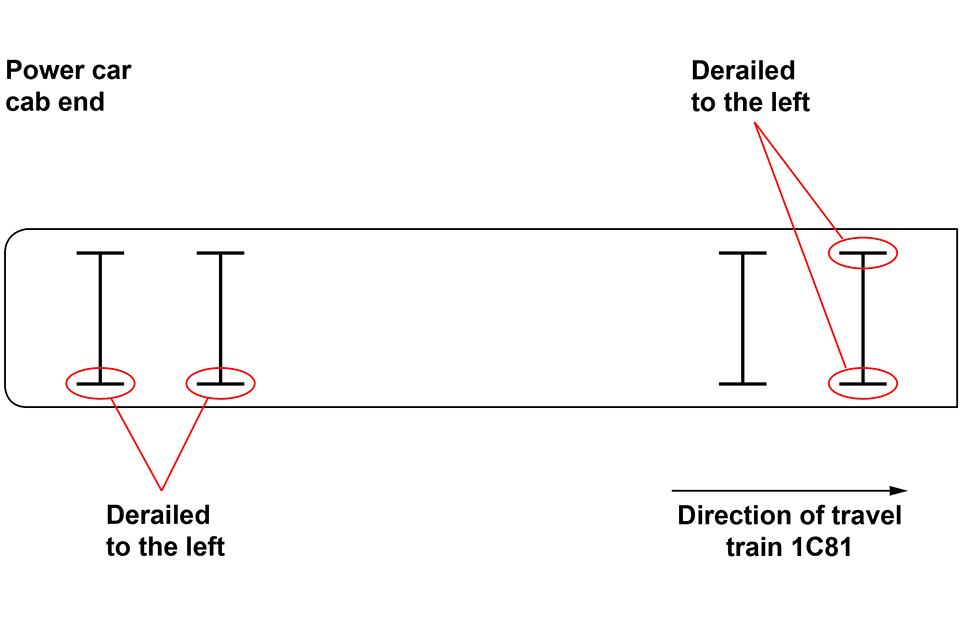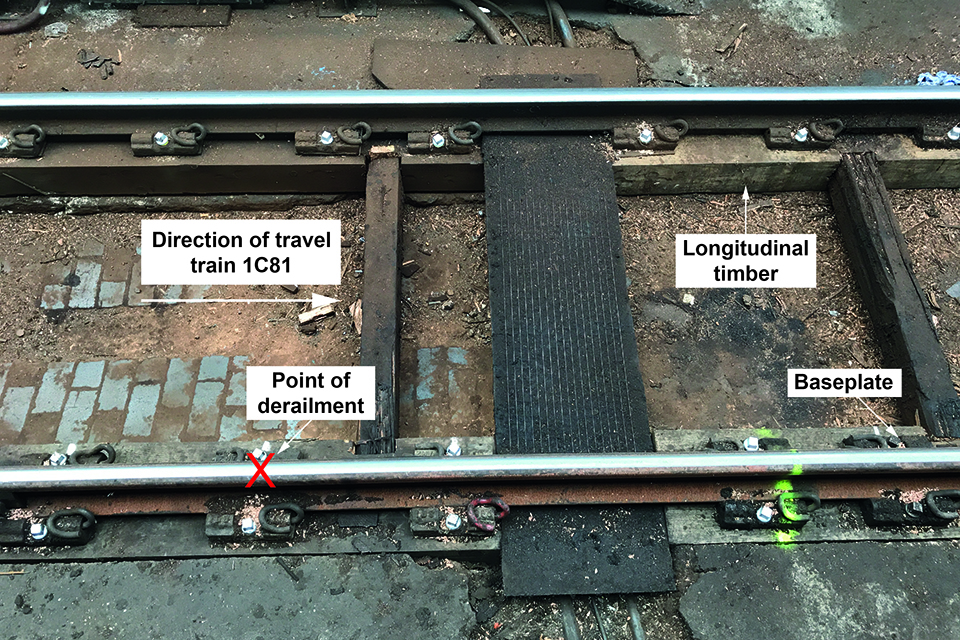Passenger train derailment, London Paddington, 20 August 2017
Published 22 November 2017
1. Important safety messages
This accident demonstrates the importance of:
- making sure that once work to renew longitudinal timbers has been identified as being necessary, it should be given an appropriate priority
- routine visual inspection of longitudinal timbers should take account of defects identified in previous detailed examinations
- when consideration is being given to prioritising project activities over remedial maintenance work, the risk of infrastructure failure is taken into account
2. Summary of the accident
The rear power car of an InterCity 125 high speed train, destined for Penzance, train number 1C81, derailed at 11:57 hrs on departure from platform 2 at Paddington station. Both wheels of the leading axle of the power car and the right-hand wheels of the trailing bogie derailed due to gauge spread (a condition in which the two rails of a track move apart, allowing train wheels to drop into the space between them).

Derailed power car at Paddington station in blue GWR livery. Four engineers in high visibility clothing are working alongside the train
The train was travelling at low speed, there were no injuries and the passengers were detrained quickly. Following recovery of the train and repairs to the track, platforms 1 and 2 fully reopened at 04:00 hrs on 22 August 2017.

Simply diagram showing which of the eight wheels on the vehicle derailed
3. Cause of the accident
The track at platform 2, Paddington station, is supported on longitudinal timbers; these run parallel to the rails and the baseplates (metal castings that hold the rail in place) are fastened to them with chairscrews. The right-hand timbers had decayed to the point that they were no longer able to maintain the alignment of the track as train 1C81 passed over them.

View of the two rails, baseplates and their fastenings showing the point of derailment. This is following repairs to the track
The train derailed because the right-hand rail moved laterally under the weight of the train. As a consequence, the first, third and fourth right-hand wheels of the power car dropped into the space between the rails. The first left-hand wheel of the power car was later forced over the left-hand rail as the gauge tightened again when the power car reached a section of track that was more securely fixed.
The failed timbers had been identified as needing replacement during their preceding detailed annual inspection, which had been carried out by the local track section manager in November 2016. The inspection report recommended that approximately 30 metres of the right-hand timbers should be changed ‘as soon as practicable’. The report also stated that the timbers were being damaged by toilet waste and water leaking from trains.

Underside of decayed right-hand timber showing wooden splinters (image courtesy of Network Rail)
Replacement of the decayed timbers was subsequently planned for June 2017. However, witness evidence indicates that this work was postponed in order that works associated with electrification of the Great Western Main Line could be carried out. At the time of the accident on 20 August, replacement of the timbers had been rescheduled for September 2017.
Detailed examination of the longitudinal timbers at Paddington station is made more difficult because only two faces of the timber are accessible to a visual inspection. The decay that was present on the underside of the timbers was therefore hidden, and it is possible that staff carrying out the routine visual inspections that were undertaken since the detailed annual examination may not have been aware of the extent of the decay. Witness evidence indicates that local track maintenance staff have since sought guidance on inspection techniques from a specialist team based in Network Rail’s Kent Route, which has more extensive experience of longitudinal timber installations.
4. Similar occurrences
On the morning of 26 August 2017, a member of the public found a section of decayed longitudinal timber, approximately 1.5 metres long, that had fallen onto the road from the railway bridge passing over the junction between St Ann’s Road and Seven Sisters Road, in the London Borough of Haringey. The timbers had been identified as requiring replacement within twelve months in each of the three preceding detailed annual inspections, however the renewal work had not been carried out due to a lack of funding. The RAIB decided not to carry out an investigation as it had no evidence that a train was involved in the incident.
On 4 February 1997, a freight train derailed on a viaduct near Bexley, Kent. Seven wagons derailed as a result of gauge spread on longitudinal timbers. The timbers had been identified as requiring urgent renewal 12 months previously, but had not been renewed. Four members of the public were injured, and extensive damage was caused to the viaduct and nearby buildings. The accident was investigated by HM Railway Inspectorate, ‘Railway accident at Bexley’, published 1999 (www.railwaysarchive.co.uk/documents/HSE_Bexley1997.pdf).
You can print this safety digest.

